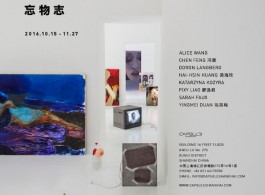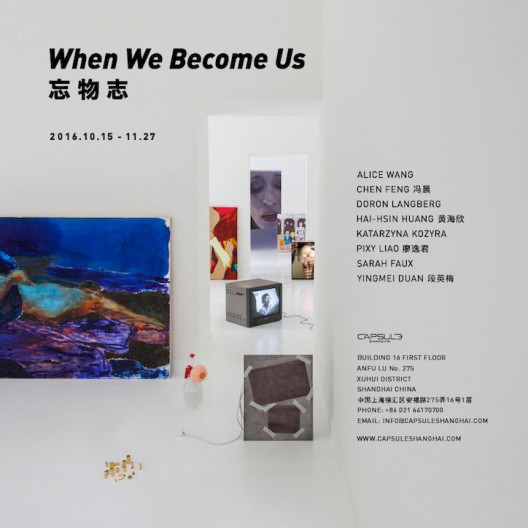Capsule, a new gallery in the heart of Shanghai’s Former French Concession, is pleased to announce its inaugural exhibition When We Become Us, on view from October 15th to November 27h. The exhibition features eight international artists working across several mediums. Each artist and their respective works have been selected for the poetic nature in which they, at times share an affinity in intent and expression, while in other instances are clearly diametrically divergent. The artists include Alice Wang, Feng Chen, Yingmei Duan, Katarzyna Kozyra, Sarah Faux, Doron Langberg, Hai-Hsin Huang, and Pixy Liao.
Collectively, the works invite us to investigate the question of how we, as viewers, approach art and what kind of catalysts are used to shape a sense of Self in relation to the Other. Consider what happens when the nature of our relationship to the work changes from a subjective to an objective reaction – is this the instant when We become Us with the artwork itself? Can this shift from subjectivity to objectivity turn our experience into something more meaningful?
LA-based artist Alice Wang (b. 1983, Xi’an, China) employs technology to explore shifts of perception in time and space. Wang’s work invites us, through our own observation, to stretch and reframe the boundaries of these elements. In the video Untitled, 2014 the physical exertion that an inversion yoga pose requires, highlights the laws of physics that govern the universe in such a way as to challenge our understanding of buoyancy and gravity. The installation Untitled, 2014, combines advanced science and photography with the mid 19th Century daguerreotype technique to capture images of electrified gas (Plasma) which are printed onto small polished aluminum plates. The resulting images are mesmerizing primordial-like forms, seemingly floating on a metal surface.
Feng Chen’s (b. 1986, Wuhan, China) work spans the disciplines of art, engineering and science, intertwined with traditional Eastern aesthetics. Feng’s earlier works employed video and video installation to “question the manipulative power of media”. While later works, influenced by his residency at Amsterdam’s Rijksakademie (2014-2015), express a deeper exploration and focus on the process of image making, to the extent that the process of making the video becomes a narrative and the artwork itself. S-1, 2016 and S-2, 2016 experiment with thermal ink, as images slowly materialize out of “nothingness”, only to disappear and reappear. His current series, 7 Real Magic Books, 2016, employs carbon fiber as a sculptural expression of images taken from ancient texts and artifacts such as The Tao and The Greek Papyri. Here, Feng uses contemporary technology in the characteristically light, but tensile carbon fiber to introduce a discussion about an ancient type of technology and magic, both of which are heavily charged subjects.
While questioning our role in time and space, the discourse often shifts to embrace topics related to gender, identity and everyday behavior.
Yingmei Duan (b. 1969, Daqing, China) began her career as a painter, eventually becoming a member of the Chinese avant-garde community in the Beijing’s East Village. After moving to Germany in 1998, Duan turned her focus on performance art, studying under teachers Marina Abramovic and Christoph Schlingensief. Duan’s art embodies her personality and often has a profound effect on her audience. A video presentation of a selection of Duan’s earlier works introduces a number of her performances, exposing viewers to emotions such as fear and desire (Sleepwalker, 2002 and Friend, 2003).
In 2013 the Huffington Post named Polish sculptor, photographer, performance artist and filmmaker Katarzyna Kozyra (b. 1963, Warsaw, Poland) as one of the ten most important female artists of the new millennium. Kozyra’s fascination with dance is often used as a platform to discuss the most fundamental issues of human existence, such as identity and transience, life and death, sex and religion. The video Faces, 2005-2006 features close-ups of dancers’ facial expressions during a performance, revealing their intense concentration, tension, and exertion, shedding light onto the grander narrative of dance that is virtually invisible to the viewer.
NY-based American painter Sarah Faux (b. 1986, Boston) depicts bodies in varying fragmented states to recreate out-of-body experiences that investigate relationships between people, body parts and physical sensations. Using a process that entails bleaching, dying and spray-painting, the resulting forms often take the shape of a tantric kaleidoscope, where “fingers, legs, nipples and hair push to foreground, never remaining at a safe distance”. Faux’s work embodies both figuration and abstraction apprehending the viewer, as in Shallow Waters, 2014 or Kindling, 2016 where we cannot help but try to analyze the work, like a sexier version of a Rorschach’s blot test.
NY-based Israeli artist Doron Langberg (b. 1985, Yokneam Moshava) defines his work as a “response to the subtle but pervasive dehumanization of queerness”, sharing his intent to “assert the validity and necessity of queerness in the greater narrative of human sexuality and identity”. The works on show depart from observational drawings (Bent #2, 2012) to depict personal interactions with both people and his immediate environment. Often charged with a raw sexual energy, Langberg’s work invites the viewer to share an intimate moment that simultaneously exposes conflicting feelings, such as erotic desire, vulnerability, awkwardness and tenderness (Sleep, 2014).
NY-based Taiwanese artist Hai-Hsin Huang (b. 1984, Taipei) uses painting and drawing tounearth what lurks beneath the surface of life’s banalities (Barber Shop # 3, 2015). Huang’s voice is one of social commentary, focusing on cross-cultural and socio-political themes that are evident, if we pay attention, in interactions between people, with our environment and with institutions of sorts. Set in the establishment of The Museum, Huang’s latest series reveals the comical side of the art world and the maniacal behavior of Museum patrons (The MET # 3, 2015).
NY-based artist, musician and actress Pixy Liao’s (b. 1979, Shanghai) social commentary takes the form of video and the use of ready-made objects to express her prickly attitude towards standardized roles in heterosexual relationships. Her sculptures Soft Heeled Shoes, 2013 and Breast Spray, 2015, with their respective accompanying videos, delve into the topics of fetish objects and gender roles. Sometimes, playfully witty, often boldly ironic, Liao’s images push the viewer to rethink the status quo, be it power symbols, our perception of social norms or the function of breasts.




